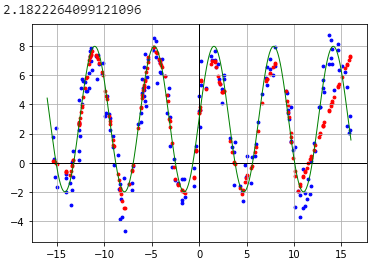I know that stochastic gradient descent always gives different results. What are the best practices to reduce this variance today? I tried to predict simple function with two different approaches and every time I train them I see very different results.
Input data:
def plot(model_out):
fig, ax = plt.subplots()
ax.grid(True, which='both')
ax.axhline(y=0, color='k', linewidth=1)
ax.axvline(x=0, color='k', linewidth=1)
ax.plot(x_line, y_line, c='g', linewidth=1)
ax.scatter(inputs, targets, c='b', s=8)
ax.scatter(inputs, model_out, c='r', s=8)
a = 5.0; b = 3.0; x_left, x_right = -16., 16.
NUM_EXAMPLES = 200
noise = tf.random.normal((NUM_EXAMPLES,1))
inputs = tf.random.uniform((NUM_EXAMPLES,1), x_left, x_right)
targets = a * tf.sin(inputs) + b + noise
x_line = tf.linspace(x_left, x_right, 500)
y_line = a * tf.sin(x_line) + b
Keras training:
model = tf.keras.Sequential()
model.add(tf.keras.layers.Dense(50, activation='relu', input_shape=(1,)))
model.add(tf.keras.layers.Dense(50, activation='relu'))
model.add(tf.keras.layers.Dense(1))
model.compile(loss='mse', optimizer=tf.keras.optimizers.Adam(0.01))
model.fit(inputs, targets, batch_size=200, epochs=2000, verbose=0)
print(model.evaluate(inputs, targets, verbose=0))
plot(model.predict(inputs))
Manual training:
model = tf.keras.Sequential()
model.add(tf.keras.layers.Dense(50, activation='relu', input_shape=(1,)))
model.add(tf.keras.layers.Dense(50, activation='relu'))
model.add(tf.keras.layers.Dense(1))
optimizer = tf.keras.optimizers.Adam(0.01)
@tf.function
def train_step(inpt, targ):
with tf.GradientTape() as g:
model_out = model(inpt)
model_loss = tf.reduce_mean(tf.square(tf.math.subtract(targ, model_out)))
gradients = g.gradient(model_loss, model.trainable_variables)
optimizer.apply_gradients(zip(gradients, model.trainable_variables))
return model_loss
train_ds = tf.data.Dataset.from_tensor_slices((inputs, targets))
train_ds = train_ds.repeat(2000).batch(200)
def train(train_ds):
for inpt, targ in train_ds:
model_loss = train_step(inpt, targ)
tf.print(model_loss)
train(train_ds)
plot(tf.squeeze(model(inputs)))


